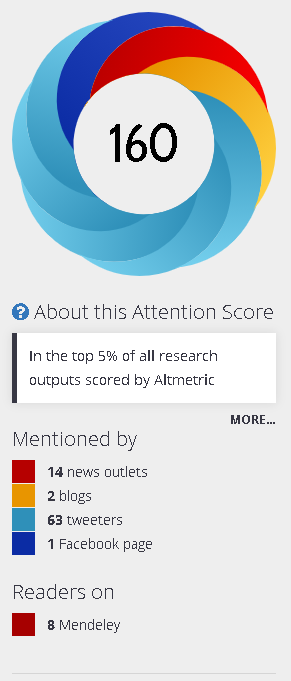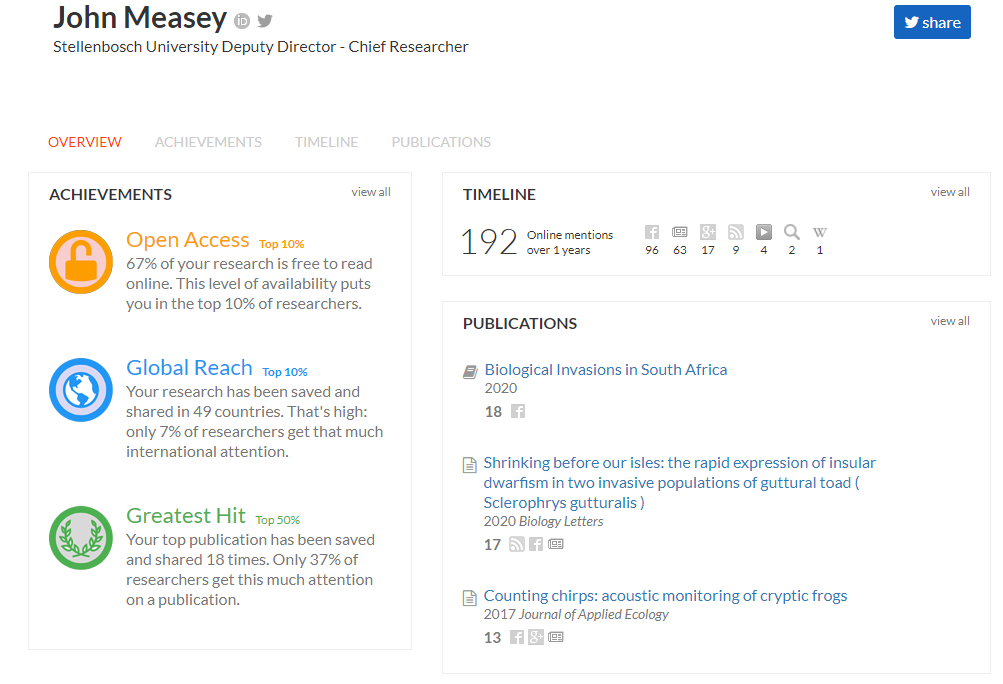26 Altmetrics from traditional and social media
In recent years, more emphasis has been placed on the way that scientists communicate their work. Many institutions now consider the degree to which scientists communicate their work as one of several key performance areas on which they are judged. Because administrators are always looking for simple solutions to evaluate the work of many different types of academics, commercial solutions to measuring the degree of communication for each publication have sprung up. The most ubiquitous of these in biological sciences are ‘altmetrics’ (Priem, Groth & Taraborelli, 2012): alternative metrics that aim to measure activity on the internet through social media (e.g. Twitter, Facebook), online reference managers (e.g. Mendeley, Zotero), blogs and news outlets. Because of the immediacy of these activities, altmetrics tend to accumulate much faster than traditional citations, giving a near immediate impression of the interest generated in an article.
A prominent company producing altmetrics for many biological journals is Altmetric (www.altmetric.com), owned by Holtzbrinck. The whirls they produce, known as ‘Altmetric badges’ are coloured to show the proportions of different media that have been scraped from the web (Figure 26.1). Although Altmetrics are widely used, the calculation of their impact score is not transparent. For example, in March 2021 they changed the weighting of their impact score so that Tweets (which were weighted at 86.9% of the score) lost 75% of their effect (Anderson, 2021). They did this without an announcement or the knowledge of their staff. Verifying the calculation of scores doesn’t always add up, and I’ve noticed that even their web crawling news coverage can be hit and miss.
A better option would be an open source tool to track altmetrics data transparently (Kramer & Bosman, 2016). Such tools have been developed (e.g Paperbuzz: paperbuzz.org and ImpactStory: profiles.impactstory.org), but at the time of writing these initiatives are unfunded and adrift.

FIGURE 26.1: The whirl output for a single paper from an Altmetrics analysis. In this example, a paper by Baxter-Gilbert et al. (2020) was covered by many Tweets, news outlets, some blogs and a Facebook mention. Altmetric provides an overall score, but different types of mentions are not, so a news outlet is awarded a higher score than a Tweet. Although this paper did not garner interest due to being a charismatic species, the story was of general interest to the public as it centred on island dwarfism. Reproduced with permission.
You can track your own altmetric profile on ImpactStory (profiles.impactstory.org) - use your ORCID number to see the altmetric impact of your articles. You’ll need to have your account visible and your profile information will get pulled through automatically to ImpactStory, although you can login and customise your profile (Figure 26.2).

FIGURE 26.2: An altmetrics profile from ImpactStory. This is my researcher profile on ImpactStory. This gives you a summary of mentions on different social media outlets for all of the publications that you have logged on your ORCID account.
In biological sciences, there is a traditional bias in media coverage towards species with higher charisma (Bonnet, Shine & Lourdais, 2002; Ducarme, Luque & Courchamp, 2013). This means that if you work on whales or roses, your work is likely to generate much higher altmetrics than if you conduct equivalent work on phasmids or grasses. Traditional media is starting to make an effort away from only reporting on science with charismatic species, but they are driven by a public with insatiable demand for kittens and flowers.
There is a lot that you can do to improve the level of your altmetrics, like writing a popular article or a press release. As communication is becoming so important in the careers of scientists, then I’d suggest that you remain aware of altmetrics and how they are used by your institution. Be aware of how to influence and increase your score. For example, if you and your friends tweet about your article, make sure that there is a live link to the article on the publisher’s website. Similarly, if you are contacted by a news outlet about some of your research, you can insist that they place a link to your paper in their article. If the Altmetric scraper cannot find coverage on your paper, you can inform them here.